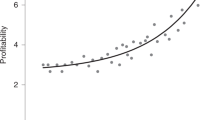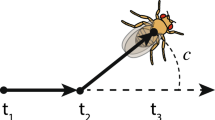Abstract
To resolve the mechanisms that switch competition to cooperation is key to understanding biological organization1. This is particularly relevant for intrasexual competition, which often leads to males harming females2. Recent theory proposes that kin selection may modulate female harm by relaxing competition among male relatives3,4,5. Here we experimentally manipulate the relatedness of groups of male Drosophila melanogaster competing over females to demonstrate that, as expected, within-group relatedness inhibits male competition and female harm. Females exposed to groups of three brothers unrelated to the female had higher lifetime reproductive success and slower reproductive ageing compared to females exposed to groups of three males unrelated to each other. Triplets of brothers also fought less with each other, courted females less intensively and lived longer than triplets of unrelated males. However, associations among brothers may be vulnerable to invasion by minorities of unrelated males: when two brothers were matched with an unrelated male, the unrelated male sired on average twice as many offspring as either brother. These results demonstrate that relatedness can profoundly affect fitness through its modulation of intrasexual competition, as flies plastically adjust sexual behaviour in a manner consistent with kin-selection theory.
This is a preview of subscription content, access via your institution
Access options
Subscribe to this journal
Receive 51 print issues and online access
$199.00 per year
only $3.90 per issue
Buy this article
- Purchase on Springer Link
- Instant access to full article PDF
Prices may be subject to local taxes which are calculated during checkout



Similar content being viewed by others
References
Bourke, A. F. G. Principles of Social Evolution (Oxford Univ. Press, Oxford, 2011)
Parker, G. A. Sexual conflict over mating and fertilization: an overview. Phil. Trans. R. Soc. Lond. B 361, 235–259 (2006)
Rankin, D. J. Kin selection and the evolution of sexual conflict. J. Evol. Biol. 24, 71–81 (2011)
Wild, G., Pizzari, T. & West, S. A. Sexual conflict in viscous populations: the effect of the timing of dispersal. Theor. Popul. Biol. 80, 298–316 (2011)
Pizzari, T. & Gardner, A. The sociobiology of sex: inclusive fitness consequences of inter-sexual interactions. Phil. Trans. R. Soc. B 367, 2314–2323 (2012)
Edward, D. A., Fricke, C., Gerrard, D. T. & Chapman, T. Quantifying the life-history response to male exposure in female Drosophila melanogaster. Evolution 65, 564–573 (2011)
Liu, H. & Kubli, E. Sex-peptide is the molecular basis of the sperm effect in Drosophila melanogaster. Proc. Natl Acad. Sci. USA 100, 9929–9933 (2003)
Chapman, T. et al. The sex peptide of Drosophila melanogaster: female post-mating responses analyzed by using RNA interference. Proc. Natl Acad. Sci. USA 100, 9923–9928 (2003)
Wigby, S. & Chapman, T. Sex peptide causes mating costs in female Drosophila melanogaster. Curr. Biol. 15, 316–321 (2005)
Fricke, C., Bretman, A. & Chapman, T. Female nutritional status determines the magnitude and sign of responses to a male ejaculate signal in Drosophila melanogaster. J. Evol. Biol. 23, 157–165 (2010)
Anxolabéhère, D. Heterosis overdominance and frequency-dependent selection in Drosophila melanogaster at the sepia locus. Evolution 30, 523–534 (1976)
Fu, W. & Noll, M. The Pax2 homolog sparkling is required for development of cone and pigment cells in the Drosophila eye. Genes Dev. 11, 2066–2078 (1997)
Partridge, L. & Fowler, K. Non-mating costs of exposure to males in female Drosophila melanogaster. J. Insect Physiol. 36, 419–425 (1990)
Tan, C. K. W. et al. Sex-specific responses to sexual familiarity, and the role of olfaction in Drosophila. Proc. R. Soc. Lond. B 280, 20131691 (2013)
Le Galliard, J. F. et al. Sex ratio bias, male aggression, and population collapse in lizards. Proc. Natl Acad. Sci. USA 102, 18231–18236 (2005)
Rankin, D. J. & Kokko, H. Sex, death and tragedy. Trends Ecol. Evol. 21, 225–226 (2006)
Rankin, D. J., Dieckmann, U. & Kokko, H. Sexual conflict and the tragedy of the commons. Am. Nat. 177, 780–791 (2011)
Fedorka, K. M. & Zuk, M. Sexual conflict and female immune suppression in the cricket, Allonemobious socius. J. Evol. Biol. 18, 1515–1522 (2005)
McInnis, D. O., Schaffer, H. E. & Mettler, L. E. Field dispersal and population sizes of native Drosophila from North Carolina. Am. Nat. 119, 319–330 (1982)
Robinson, S. P., Kennington, W. J. & Simmons, L. W. Preference for related mates in the fruit fly, Drosophila melanogaster. Anim. Behav. 84, 1169–1176 (2012)
Hamilton, W. D. Altruism and related phenomena, mainly in social insects. Annu. Rev. Ecol. Syst. 3, 193–232 (1972)
Bourke, A. F. G. & Frank, N. R. Social Evolution in Ants (Princeton Univ. Press, 1995)
Packer, C. & Pusey, A. E. Cooperation and competition within coalitions of male lions: kin selection or game theory. Nature 296, 740–742 (1982)
McDonald, D. B. & Potts, W. K. Cooperative display and relatedness among males in a lek-mating bird. Science 266, 1030–1032 (1994)
Petrie, M., Krupa, A. & Burke, T. Peacocks lek with relatives even in the absence of social and environmental cues. Nature 401, 155–157 (1999)
Krakauer, A. H. Kin selection and cooperative courtship in wild turkeys. Nature 434, 69–72 (2005)
Den Boer, S., Baer, B. & Boomsma, J. J. Seminal fluid mediates ejaculate competition in social insects. Science 327, 1506–1509 (2010)
Moore, A. J. & Pizzari, T. Quantitative genetic models of sexual conflict based on interacting phenotypes. Am. Nat. 165, S88–S97 (2005)
Eldakar, O. T., Dlugos, M., Pepper, J. W. & Wilson, D. S. Population structure mediates sexual conflict in water striders. Science 326, 816 (2009)
Buckling, A. & Brockhurst, M. A. Kin selection and the evolution of virulence. Heredity 100, 484–488 (2008)
Clancy, D. J. & Kennington, J. A simple method to achieve consistent larval density in bottle cultures. Drosoph. Inf. Serv. 84, 168–169 (2001)
Quinn, G. P. & Keough, M. J. Experimental Design and Data Analysis for Biologists. (Cambridge Univ. Press, 2002)
Kleinbaum, D. G. & Klein, M. Survival analysis: A self-learning text. 3rd edn (Springer, 2012)
Charlesworth, B. Selection in populations with overlapping generations. I. The use of Malthusian parameters in population genetics. Theor. Popul. Biol. 1, 352–370 (1970)
Prout, T. & McChesney, F. Competition among immatures affects their adult fertility: population-dynamics. Am. Nat. 126, 521–558 (1985)
McGraw, J. B. & Caswell, H. Estimation of individual fitness from life-history data. Am. Nat. 147, 47–64 (1996)
Bastock, M. & Manning, A. The courtship behaviour of Drosophila melanogaster. Behaviour 8, 85–111 (1955)
Chen, S., Lee, A. Y., Bowens, N. M., Huber, R. & Kravitz, E. A. Fighting fruit flies: A model system for the study of aggression. Proc. Natl Acad. Sci. USA 99, 5664–5668 (2002)
Jacobs, M. E. Influence of light on mating of Drosophila melanogaster. Ecology 41, 182–188 (1960)
Dierick, H. A. A method for quantifying aggression in male Drosophila melanogaster. Nature Protocols 2, 2712–2718 (2007)
Nilsen, S. P., Chan, Y.-B., Huber, R. & Kravitz, E. A. Gender-selective patterns of aggressive behaviour in Drosophila melanogaster. Proc. Natl Acad. Sci. USA 101, 12342–12347 (2004)
McCullagh, P. & Nelder, J. A. Generalized Linear Models. 2nd edn (Chapman & Hall, 1989)
Liggett, R. E. & Delwiche, J. F. The beta-binomial model: variability in overdispersion across methods and over time. J. Sens. Stud. 20, 48–61 (2005)
Acknowledgements
We thank the following funding agencies: Marie Curie fellowship (PIEF-GA-2010-273010 to P.C.), the Wellcome Trust VIP award and NERC fellowship (to S.W.), NERC research grant and the Leverhulme Trust (to T.P.). We thank C. Garroway, J. Perry and S. Michaelides for technical help; and M. Bonsall, A. Buckling, G. McDonald, D. Noble, J. Perry, P. Pizzari, R. Snook and S. West for helpful discussions.
Author information
Authors and Affiliations
Contributions
Experiment 1 was designed by P.C., S.W. and T.P., conducted by P.C. and F.A., and analysed by P.C. Experiment 2 was designed by P.C., C.K.W.T., S.W. and T.P., and conducted and analysed by P.C. Experiment 3 was designed and conducted by S.W. and P.C., and analysed by P.C. Experiment 4 was designed by C.K.W.T., T.P. and S.W., and conducted and analysed by C.K.W.T. The article was conceived and written by T.P. with input from P.C., C.K.W.T. and S.W.
Corresponding author
Ethics declarations
Competing interests
The authors declare no competing financial interests.
Additional information
Data have been deposited in the Dryad Digital Repository at http://dx.doi.org/10.5061/dryad.9c7bq.
Extended data figures and tables
Extended Data Figure 1
a, Rate-sensitive estimates of individual female fitness (wind) over a gradient in population growth rates (r). Female fitness was estimated to be higher under high within-group male relatedness for values of r ranging from −0.1 to 0 (dark shaded area), a similar non-significant (0.05 < P < 0.08) pattern was extended for r = −0.2 and r = 0.1 (light shaded area). b, The effect of within-group male relatedness on population fitness. The relative fitness cost of reducing within-group male relatedness at different population growth rates (r). The dashed line identifies relative fitness of 1, where reduction in within-group male relatedness has no fitness cost. Reducing within-group male relatedness is always costly over the range of population growth rates explored, but particularly so with smaller growth rates.
Rights and permissions
About this article
Cite this article
Carazo, P., Tan, C., Allen, F. et al. Within-group male relatedness reduces harm to females in Drosophila. Nature 505, 672–675 (2014). https://doi.org/10.1038/nature12949
Received:
Accepted:
Published:
Issue Date:
DOI: https://doi.org/10.1038/nature12949
This article is cited by
-
Small-scale genetic structure of populations of the bulb mite Rhizoglyphus robini
Experimental and Applied Acarology (2023)
-
Kin discrimination and demography modulate patterns of sexual conflict
Nature Ecology & Evolution (2020)
-
Males optimally balance selfish and kin-selected strategies of sexual competition in the guppy
Nature Ecology & Evolution (2020)
-
Kin discrimination allows plants to modify investment towards pollinator attraction
Nature Communications (2018)
-
An experimental test of relatedness-based mate discrimination in a social lizard
Behavioral Ecology and Sociobiology (2016)
Comments
By submitting a comment you agree to abide by our Terms and Community Guidelines. If you find something abusive or that does not comply with our terms or guidelines please flag it as inappropriate.



